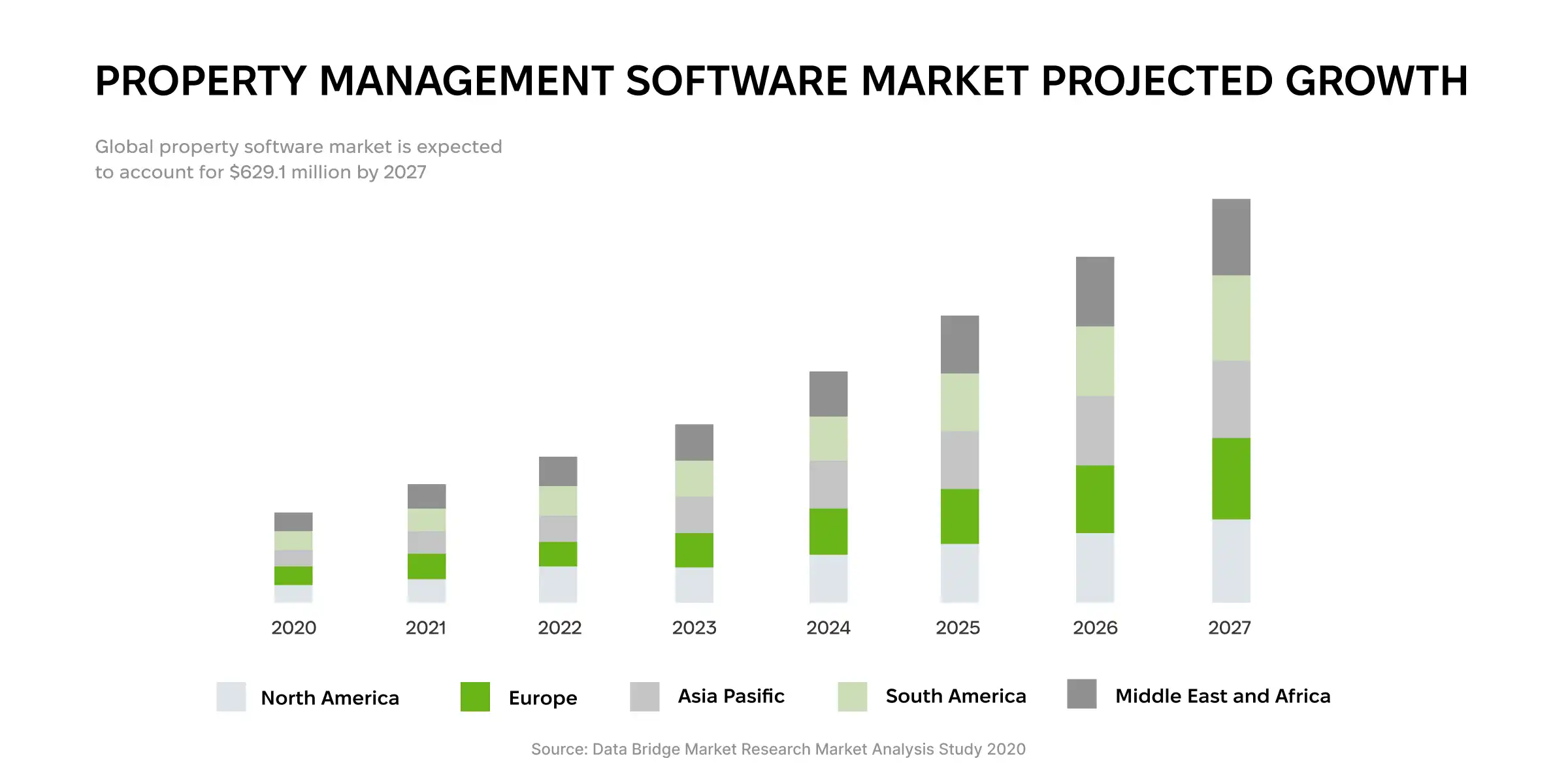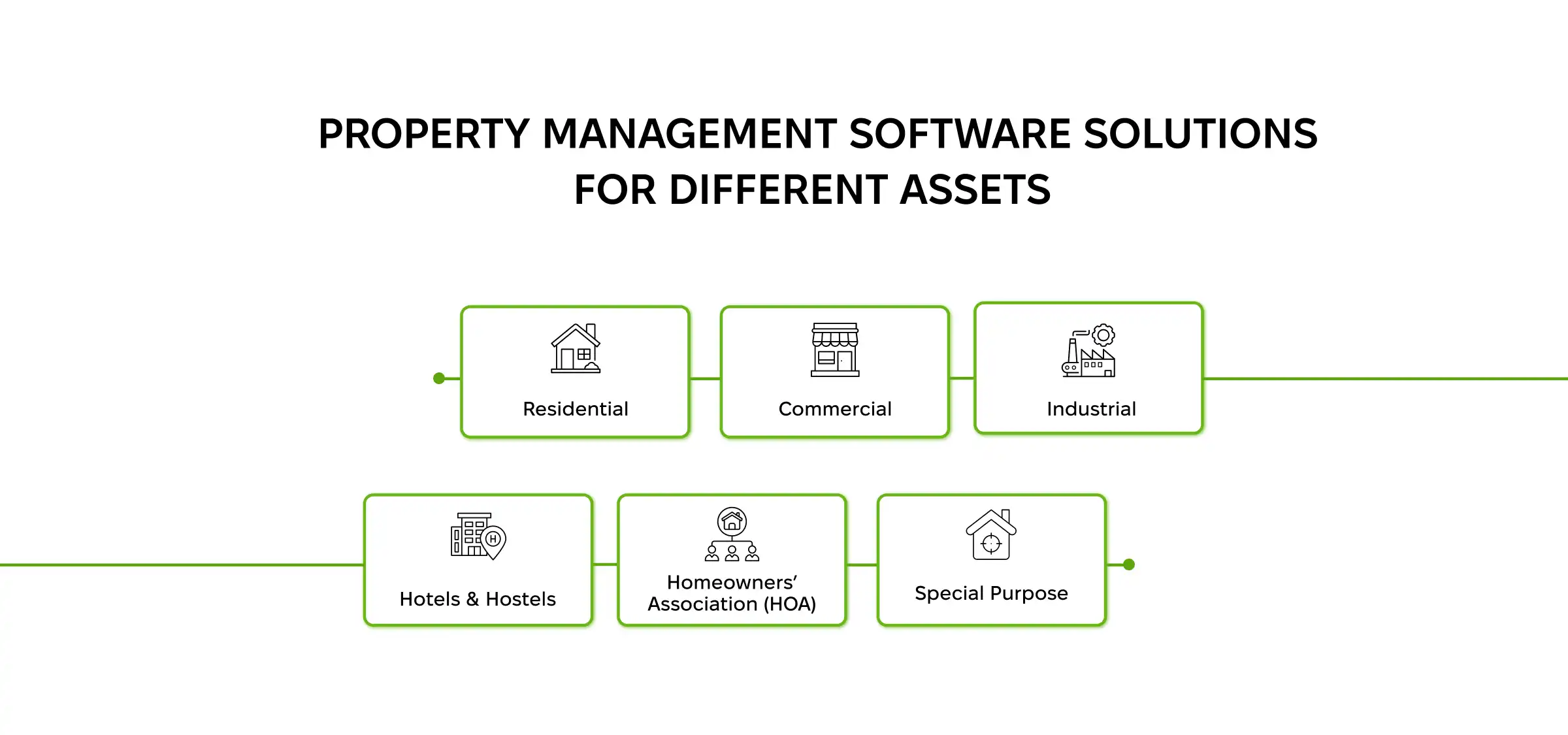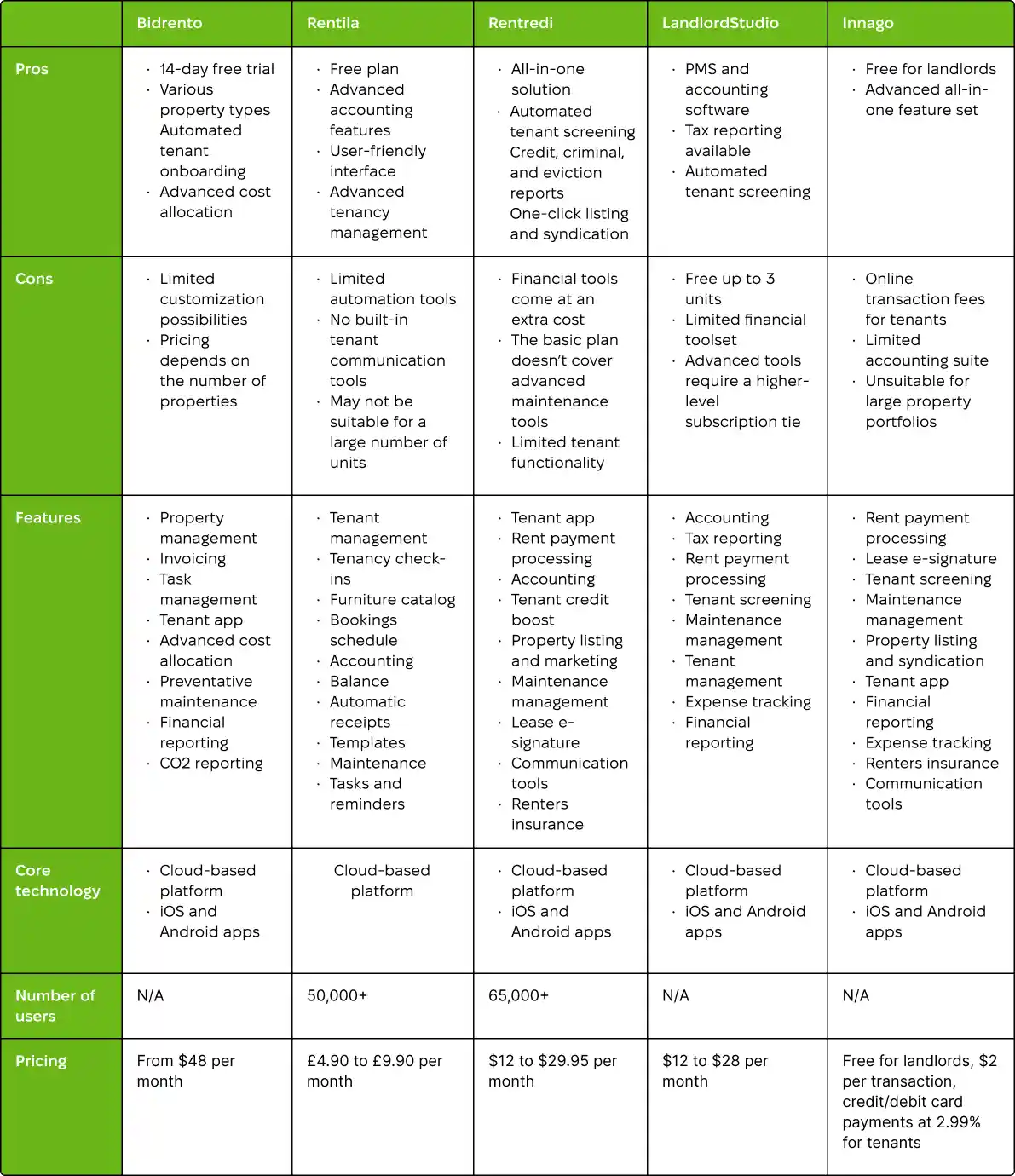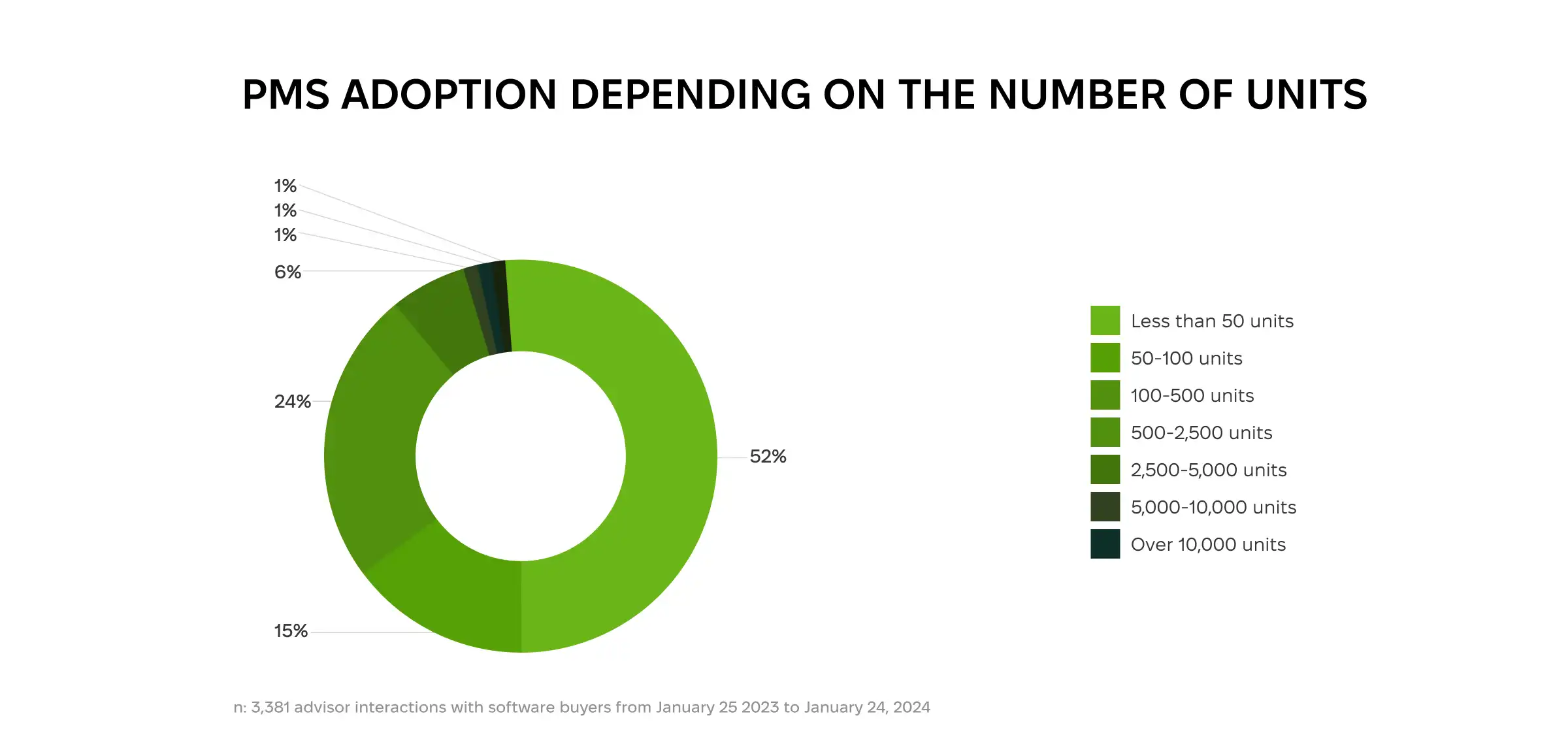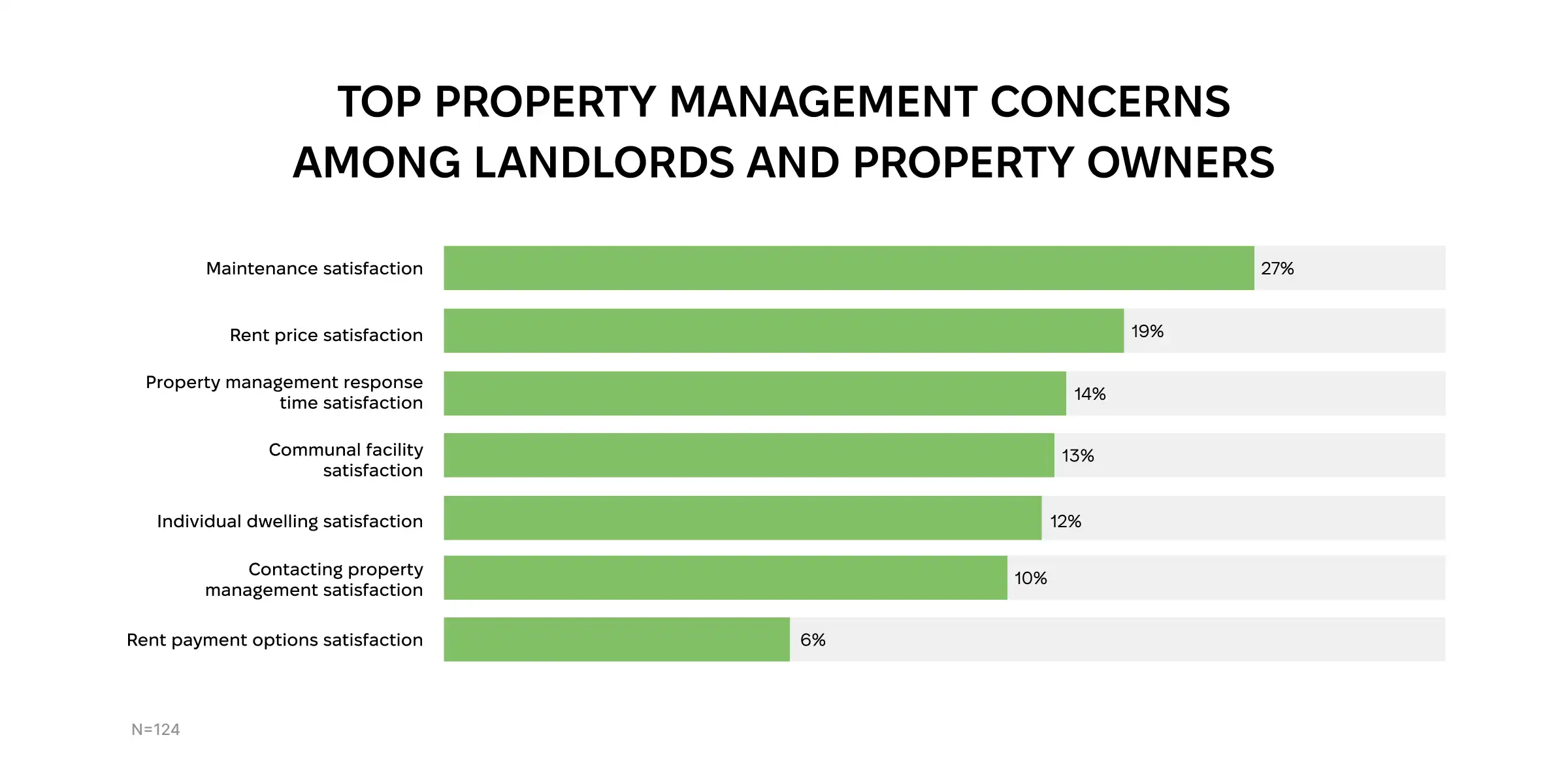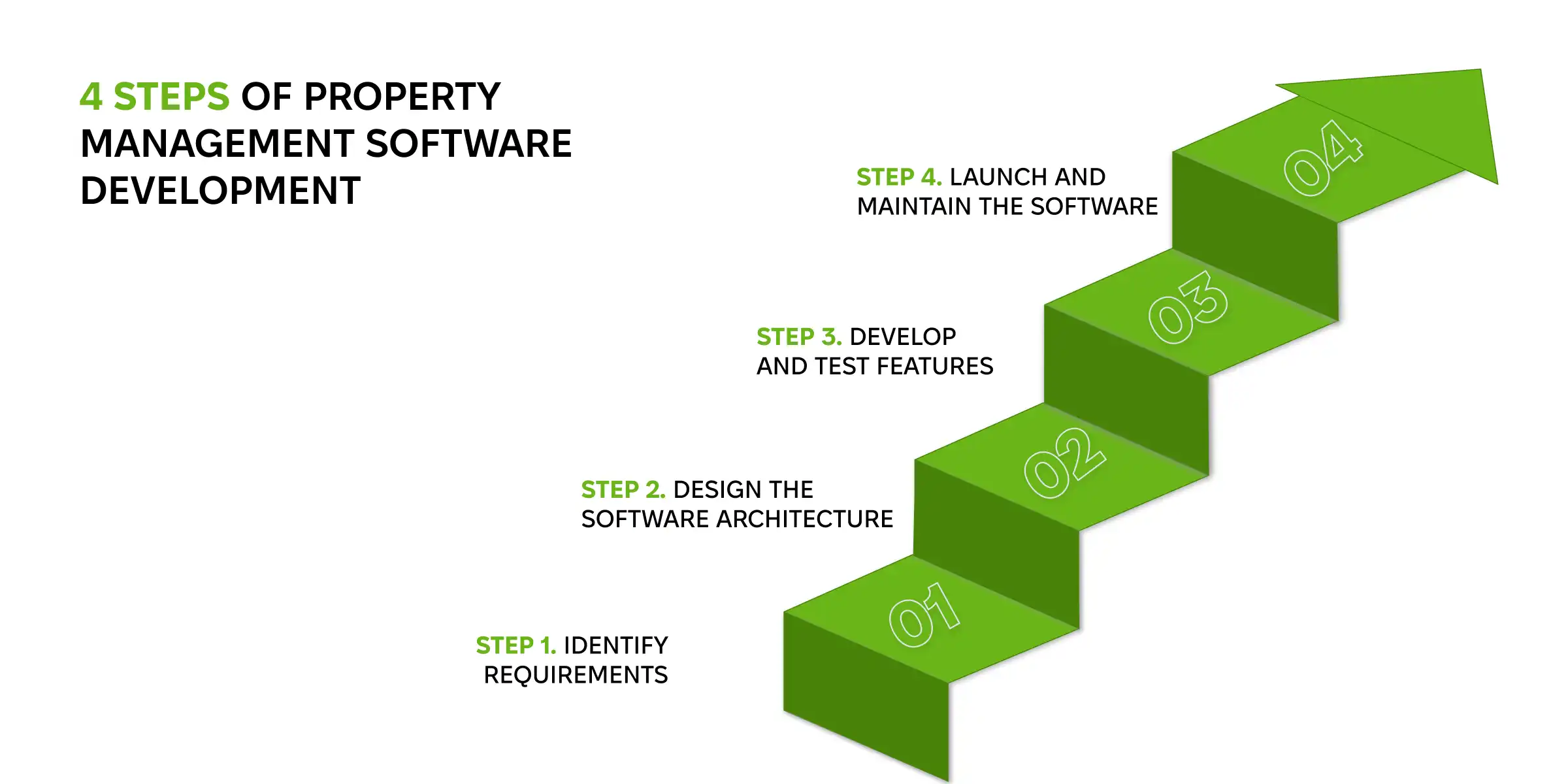Inefficiency plagues landlords and property managers with multiple units. Property management software can solve most of their issues and boost tenant satisfaction. And if off-the-shelf solutions can’t address all challenges, custom property management software development is the answer.
Maintenance issues and low efficiency are the biggest challenges among property managers. Property management software development helps overcome them by automating routine tasks, improving tenant-landlord communication, and centralizing operations.
PropTech adoption among real estate companies and property managers went
from 48% to over 70%
in the last four years. It will continue to grow, adopting disruptive technologies like IoT and AI to improve managers’ and tenants’ experience. In this post, we’ll explore ready-made solutions and go over the basics of apartment rental management software development based on Exoft's experience in PropTech and
construction software development.
Highlights:
- Property management software increases efficiency, enhances tenant experience, and increases asset value, among other benefits.
- Landlords and property managers can choose between off-the-shelf SaaS solutions and custom property management software development.
- Ready-made apps lack advanced features and integration capabilities of custom development solutions.
- Core PMS functionality includes tenant management and communication, maintenance management, payment processing, and analytics.
Market Overview of Property Management Software
Property management software (PMS) is a solution for residential and commercial landlords and property managers. It's a digital alternative to paper bookkeeping and spreadsheets with tenant, lease, and maintenance data.
Early-days property management solutions addressed specialized tasks, like accounting or tenant communication. Modern-day software suites combine multiple modules for everything from listing vacancies to storing leases, accounting, and tax filing.
The PropTech market addresses property management needs across various sectors, including residential, hotels and hostels, commercial and industrial assets. There are also niche apps for homeowners’ associations (HOA) and special-purpose properties that don’t fall into the other categories.
There are dozens of ready-made SaaS solutions on the market. Still, some landlords opt for custom rental management software development to ensure the best fit for their daily operations. We analyze five popular property management solutions to help you decide which way to go. You can find their advantages and drawbacks in the table:
|
Bidrento |
Rentila |
Rentredi |
LandlordStudio |
Innago |
|---|
| Pros |
14-day free trial
Various property types
Automated tenant onboarding
Advanced cost allocation
|
Free plan available
Advanced accounting features
User-friendly interface
Advanced tenancy management
|
All-in-one solution
Automated tenant screening
Credit, criminal, and eviction reports
One-click listing and syndication
|
PMS and accounting software
Tax reporting available
Automated tenant screening
|
Free for landlords
Advanced all-in-one feature set
|
|---|
| Cons |
Limited customization possibilities
Pricing depends on the number of properties
|
Limited automation tools
No built-in tenant communication tools
May not be suitable for a large number of units
|
Financial tools come at an extra cost
The basic plan doesn’t cover advanced maintenance tools
Limited tenant functionality
|
Free up to 3 units
Limited financial toolset
Advanced tools require a higher-level subscription tier
|
Online transaction fees for tenants
Limited accounting suite
Unsuitable for large property portfolios
|
|---|
| Features |
Property management
Invoicing
Task management
Tenant app
Advanced cost allocation
Preventative maintenance
Financial reporting
CO2 reporting
|
Tenant management
Tenancy check-ins
Furniture catalog
Bookings schedule
Accounting
Balance
Automatic receipts
Templates
Maintenance
Tasks and reminders
|
Tenant app
Rent payment processing
Accounting
Tenant credit boost
Property listing and marketing
Maintenance management
Lease e-signature
Communication tools
Renters insurance
|
Accounting
Tax reporting
Rent payment processing
Tenant screening
Maintenance management
Tenant management
Expense tracking
Financial reporting
|
Rent payment processing
Lease e-signature
Tenant screening
Maintenance management
Property listing and syndication
Tenant app
Financial reporting
Expense tracking
Renters insurance
Communication tools
|
|---|
| Core technology |
Cloud-based platform
iOS and Android apps
|
Cloud-based platform
|
Cloud-based platform
iOS and Android apps
|
Cloud-based platform
iOS and Android apps
|
Cloud-based platform
iOS and Android apps
|
|---|
| Number of users |
N/A |
50,000+ |
65,000+ |
N/A |
N/A |
|---|
| Pricing |
From $48 per month |
£4.90 to £9.90 per month |
$12 to $29.95 per month |
$12 to $28 per month |
Free for landlords, $2 per transaction, credit/debit card payments at 2.99% for tenants |
|---|
As you can see, the features are pretty similar across the board, though specific tools and customization potential depend on the chosen product. The pricing tiers can also affect the toolset. However, none of these platforms is a truly all-in-one solution addressing landlords’ every need. You can only combine their strengths through custom software development.
Key Features to Look for in Apartment Rental Management Software
With ready-made landlord software solutions, you have to settle for the toolset they offer. But they rarely fit your daily operations perfectly, especially if you already use other software products.
That’s where custom property management solutions come in. Instead of paying for something you don’t need and missing other tools, you can pick and choose critical features and expand the list down the road when the software starts paying for itself.
Here are the features any property management software should have:
- Lease management.
This toolset includes everything from drafting standard leases to storing them. It can also help you track upcoming lapses and renewals and notify landlords, property managers, and tenants.
- Rent collection and tracking.
Built-in payment processing capabilities let tenants pay their rent and maintenance fees online. Flexible notifications give landlords a clear view of on-time and late payments.
- Maintenance management.
This module collects tenant’s maintenance requests and helps the landlord schedule repairs, assign contractors, and monitor the maintenance progress. Predictive maintenance also becomes an option to prevent emergencies.
- Tenant screening and communication.
Email, chat, and other communication tools help landlords screen potential tenants, perform onboarding, run surveys, and collect feedback.
- Financial management and accounting.
Accepting and processing payments are among the most sought-after features in property management solutions, as they speed up and simplify transactions for tenants and bookkeeping for landlords. Accounting tools can factor in expenses and deal with tax forms and other tasks without using other software solutions.
- Centralized data storage.
Storing all property management documentation in a single database makes data processing and protection easier. Using centralized storage also helps landlords fulfill privacy protection regulatory requirements.
- Financial reporting and analytics.
Report templates and automatically generated reports are vital for long-term decision-making. Landlords can analyze occupancy, financial metrics, tenant satisfaction rates, and other factors to increase income.
- Integration with other tools and platforms
maximizes the effect of different business tools, such as CRM, payment processing systems, email services, or smart devices in the building.
- Mobile access.
Mobile-friendly web platforms and native iOS and Android apps let landlords, maintenance teams, and tenants exchange information and address issues in real time from any place with a stable internet connection.
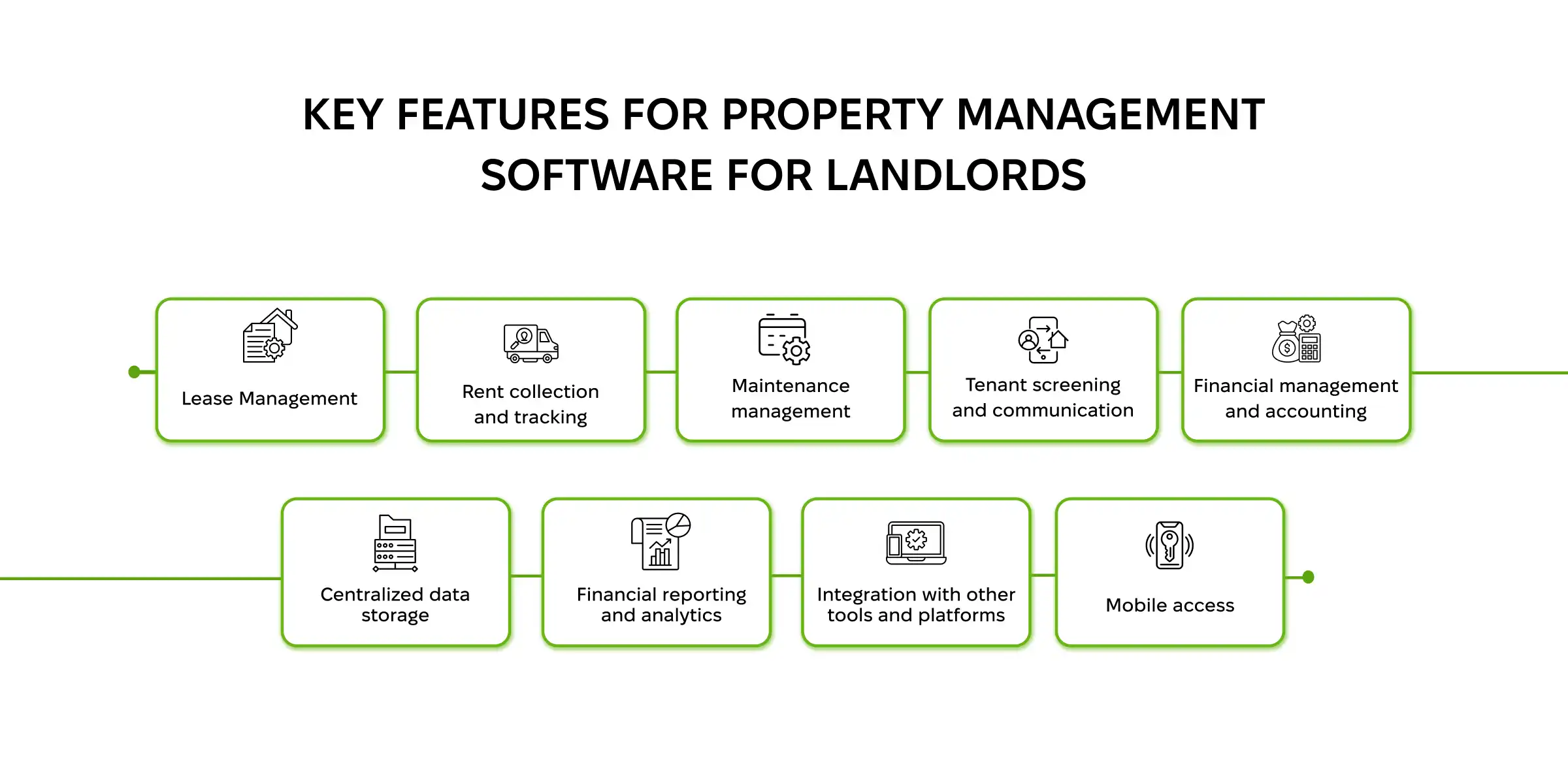
According to Exoft software engineers, “Sky is the limit in landlord management software development. It can be a web-based platform or a mobile app. We can set it up on a local server or in the cloud and use frameworks and libraries that work with the rest of your company’s software ecosystem. For example, we don’t have to build a separate time booking tool if you already have one. We’ll build a solution that will work perfectly with what you already use to save resources.”
Why Create a PMS Solution for Landlords in 2025?
According to the Global Real Estate Technology Survey, four of five real estate professionals plan to invest more in technology. PropTech investment went from $1.2 to $1.8 billion between 2021 and 2023. And 72% of real estate companies already use some form of PropTech. More plan to do so in the future.
If you’re still on the fence, here’s a sneak peek of the benefits you can reap with software development for landlords:
- Improved efficiency and time savings.
63% of PropTech adopters report increased operational efficiency. Timely notifications and automated processes reduce routine tasks and the chance of human error. Instead of wasting time looking for necessary data in filing cabinets or spreadsheets, landlords can access it in a unified database.
- Enhanced tenant experience.
57% of the survey responders claim an increase in tenant satisfaction rates, which leads to lower churn and a reduced number of vacancies. Both result in better financial outcomes for landlords and property managers. This increase in satisfaction is a product of quick response times and faster maintenance ticket handling you can achieve through real-time communication tools and instant notifications.
- Better financial management.
Centralized storage and management of all accounting and financial data helps control income and expenses. Thanks to rent payment notifications and reminders, landlords can reduce the number of late payments. At the same time, accounting tools help keep track of maintenance and other expenses. Reporting tools help make better decisions and predict upcoming income based on past trends. Moreover,
52% of software adopters claim increased asset value.
- Simplified compliance and reporting.
PMS tools help property owners ensure local and federal regulation compliance thanks to careful record-keeping and automated reminders for regulatory tasks, like filing forms and paying fees. It can even save landlords money by preventing late submissions and payments that could lead to fines.
- Future business growth.
Property management software lets landlords scale their operations smoothly without incurring extra personnel expenses. Thanks to automated processes, communication tools, and accounting features, they can add new units to their portfolios without hiring a full management team. Moreover, many property management tools incorporate listing and syndication functionality to speed up the search for new tenants.
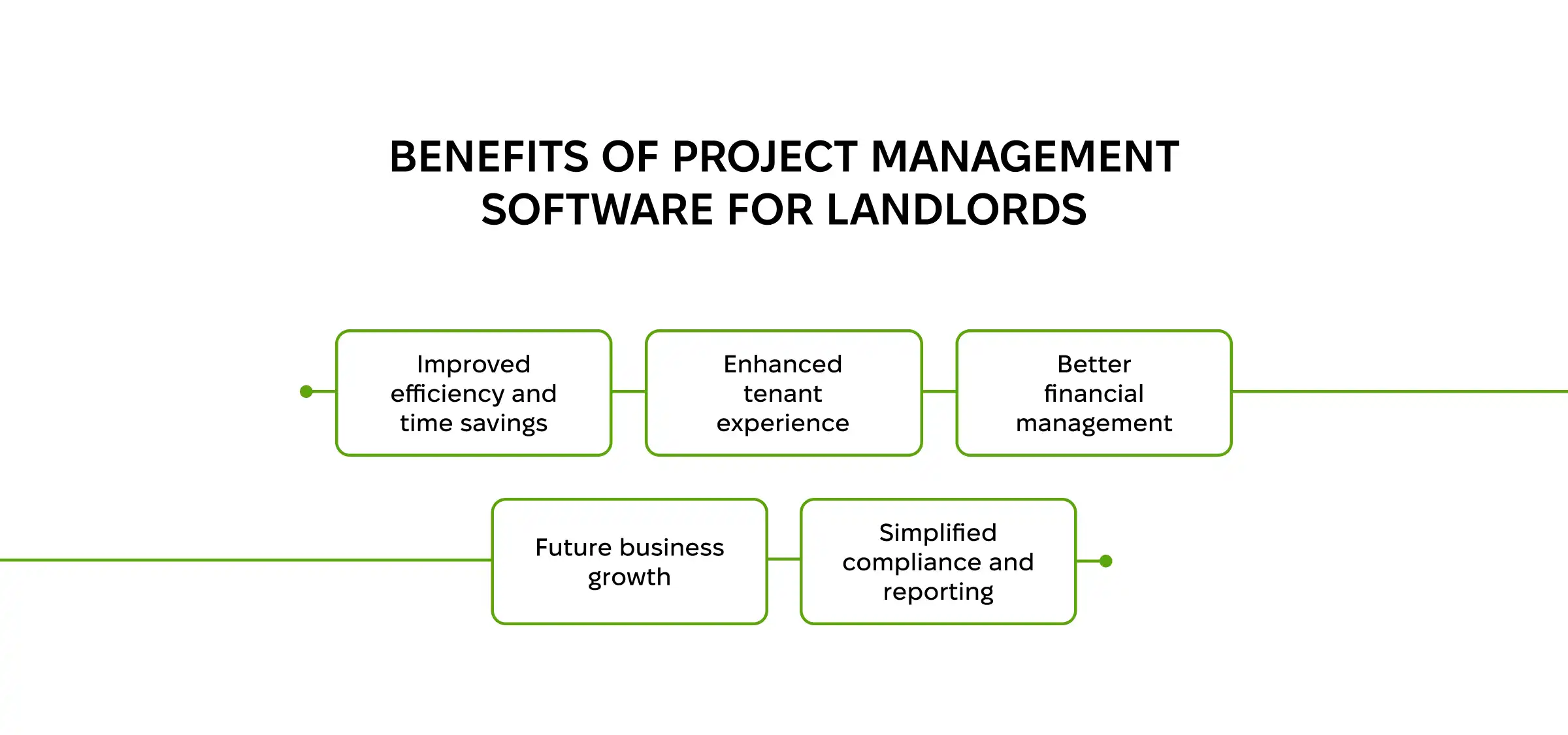
Unlike ready-made solutions, custom landlord management software development does not face common integration challenges. Still, it does require significant upfront costs and just as much user training to be effective. Still, a convenient software solution can help landlords scale their businesses and maintain property value in a volatile economy.
4 Steps of All-in-One Property Management Software Development
If no ready-made PMS solutions address your needs, consider developing custom software. With an outsourcing partner like Exoft, the discovery, development, and launch processes will run without a hitch.
Step 1. Identify Requirements
Explore the ready-made solutions and analyze your property management operations to identify the core requirements. A business analyst can work with you at the discovery stage to prepare the brief for the technical team to work on.
Aside from the feature set, consider the following requirements before launching property management software development for landlords:
- Integrations with other software solutions or systems
- Communication tools
- Core technologies and architecture
- Access roles
- Security features
- Regulatory compliance
- Scaling possibilities, etc.
Creating a list of measurable requirements at the discovery stage is important. Instead of vague statements, focus on hard numbers and metrics. For instance, specify the exact number of employees and tenants who should be able to use the app simultaneously without crashing.
If you manage five units but plan to expand your asset portfolio, you must account for the increasing load and traffic capabilities. Instead of wasting money on excessive functionality upfront, you can choose scalable solutions that will grow with your business needs. If your solution has unique selling points, you can transform it into a
multi-tenant SaaS platform
and create a new revenue stream.
Step 2. Design the Software Architecture
Your technical team will suggest the best approach to software development for landlords based on your requirements. Still, there are some things you should discuss with software engineers before the project begins:
- Cross-platform or native Android and iOS development
- On-site or cloud implementation
- Offline and online capabilities
- Technology stack
- Architecture requirements
At Exoft, we can design a modular application and develop and launch the tenant management and payment support capabilities before working on maintenance management and communication features. This approach reduces upfront investment and lets you roll out the PMS solution one step at a time, reducing friction among your property managers.
Step 3. Develop and Test Features
Creating a minimum viable product (MVP) is usually the first step of the rental property management software development process. It includes frontend and backend development.
Frontend development deals with
UI/UX design,
wireframing, and user-facing features. It’s critical for delivering a smooth user experience and improving tenant satisfaction rates. Proper UX can also reduce adoption friction among your employees, so it’s a vital development step you shouldn’t rush.
Backend development deals with the server-facing aspects of your solution, but it’s equally important. The technology stack and implementation steps will define your project’s efficiency, response time, and bug-free operation.
Of course, testing is also a vital step of the development process. Quality assurance ensures the solution fulfills your requirements and operates properly. The testing schedule depends on the project management approach your technical team uses. Still, the final solution will go through multiple manual and automated tests before launching.
Step 4. Launch and Maintain the Software
The launch process depends on your architecture decisions. For example, if you select a cloud-based solution, it can be ready for use immediately after going live. You can first introduce it to your employees and maintenance staff before making it available for tenants.
It’s important to provide instructional materials to ensure users are comfortable with all features and to minimize security vulnerabilities. You should also collect user feedback to learn about any possible bugs, errors, and shortcomings. The first reviews will help you adjust and improve the custom property management solutions before working on major upgrades.
Do not ignore regular maintenance and technical support. Although software solutions can run without them, regular security updates and small bug fixes will ensure their stability in the long term. Scheduled maintenance will also prevent unexpected crashes and reduce software downtime, improving user experience.
Conclusion
Real estate may be the landlords’ market for now, but handling multiple properties, reducing tenant churn, and minimizing vacancies remain among the top challenges for property owners and landlords. Adopting property management software for landlords increases daily efficiency, boosts tenant satisfaction, and raises property values. Moreover, advanced all-in-one solutions help scale businesses and introduce new revenue streams.
Exoft can help you work out the requirements and develop and launch landlord software solutions. Check out our
case study
library to see our most successful projects. Or
contact us
to schedule a consultation.
Frequently asked questions
Can property management software integrate with existing systems and tools I currently use?
Off-the-shelf SaaS property management solutions usually offer limited integration and synchronization capabilities. Custom software development achieves the best integration with the tools you currently use. With ongoing maintenance and support, you can add new integrations down the line if you adopt additional tools.
What customizable features or modules can I add to serve my unique property management needs?
With custom property management software development for landlords, you can get any unique features and modules you need. For example, you can integrate the IoT system in your building with the property management software to track electricity, water, and heating consumption. Custom communication tools can help you set up regular newsletters and notifications based on tenant activity, like late payment reminders, maintenance warnings, or thank-you notes.
What security measures can I use to protect tenants’ sensitive personal and financial information?
The Exoft team will suggest the security best practices your property management solution should have. These include data encryption, limited data access based on user roles, multi-factor authentication, and a password validation process. At the same time, employee and user training are also important to prevent data leaks.
Can a CRM or ERP solution replace specialized property management software?
Universal one-size-fits-all solutions can take over some of the features of property management software. However, they will inevitably lack some features as they aren’t tailored for managing a property portfolio or tenant relationships. You’ll have to adjust your daily operations or combine several solutions to make them work. Still, ready-made CRM and ERP solutions are more affordable than customer PMS development.
What are the benefits of cloud-based property management solutions over on-site deployment?
Cloud-based solutions are more scalable and offer advanced data security while reducing the initial investment requirements. You will not need to purchase and maintain server hardware or employ an IT team to support the infrastructure. You will also be able to scale your PMS solution instantly. However, cloud-based solutions come with subscription fees, which get steeper the more assets you manage and the more resources you use.
